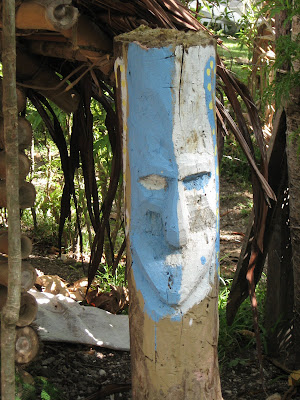below will show you (with any luck) just how gorgeous the kids of Vanuatu are, their eyelashes are wonderfully long and the smiles of their faces seem to emit an angelic light.

The bus took us through Vila where we stopped at a few places to take in the view and get our bearings.



The bus took us to La Lagoon to paddle across the lagoon on a traditional dug out canoe.





The chief of the Small Numbas tribe (from Malakula) paddled us across the lagoon. I asked if I could paddle too and he of course said yes. I remembered growing up, being told the difference between the way a man handles a paddle (one hand on the very end of the handle) compared with that of women (one hand part way down the handle - so women could paddle whilst carrying their children without interfering with their children s comfort). I paddled this way and I think that the chief was quietly surprised and grateful for the help. The paddles are marked with the colours of the Vanuatu flag - Black to represent the indigenous skin, Red to signify the sun, Green to represent the plants and Yellow to signify goodwill to all men.



The village is called "Amelgorie"



Once on the other side of the lagoon we were greeted by a pretty girl who warned us not to be too shocked by the surprise to come. As we entered the ceremonial village grounds the males of the tribe (dressed in all their regalia) jumped out at us yelling. It was great, seeing the guys trying to be serious and scary. The Small Numbas tribe is so called because their 'cod-pieces' (for want of another descriptor) are relatively small. There is also a Big Numbas tribe whom wear large 'cod-pieces'.
The tribesmen showed us some of their traditional dances which I will upload to Youtube as soon as time permits.



They also showed us their traditional fire-making techniques.
After the show we were invited to have afternoon tea of local tropical fruits and juice, the mango was delicious and I don't think I've ever tasted sweeter pineapple (and that's saying something considering I grew up in North Queensland). As Emma and I were eating the boys chatted to the male members of the tribe. I had earlier seen hubby eyeing off the war clubs the men had used during the ceremonial dances, I knew he wouldn't be able to resist seeing if they would let him give it a swing. It was then that I noticed the pretty girl that had guided us into the village eyes widen, she frantically asked who 'he' was. I told her that the guy she was asking about was my husband, she looked at me, eyes wide and said "your husband - Tuff TUMAS!" I turned around just in time to catch hubby swinging the war club in his precise martial manner and smiled, a feeling of intimate pride swimming over me. The people of Vanuatu use the phrase tuff tumas quite often but I'd never heard it said with such enthusiasm.

Hubby informed me later that the cultural chief of the village had explained a bit about the use of ceremonial war clubs in their culture dances and within their culture in general. The design of the war clubs are not traditional to Vanuatu or the Small Numbas tribe but rather are designs based on the 'Pacific Forum' the designs on the war clubs include symbols of indigenous and Caucasian peoples joining together. Hubby also found out that they Vanuatu men didn't 'train' in warfare specifically, instead they have warrior dances were they attack and defend at full force to the music of their culture songs, if the dances are not performed correctly the chances of severe injury become quite common.
I asked the men about the decorations I noticed painted on their bodies for the dancing. They showed me the tribal markings that represent the centipede (the only dangerous animal in Vanuatu) and the palm frond markings on their chest are that of an indigenous short leaved palm prevalent on the islands of Vanuatu.The village was surrounded by 'totem-pole type guys' which were told to us to be watching demons. The eyes of these 'demons' are hollowed out and the statues face the ceremonial grounds of the village, the most central locations. We were informed that the watching demons had their eyes removed so they can not see the digressions of those within the tribe, they are there to protect the village people and save them from unfair judgment.











After the festivities the culture group availed us some photographic opportunities.
We were invited to take some staged photos where the guys were pretending to kidnap us girls - fun times!


Upon our return canoe journey we were complimented on our friendliness (a strange concept considering how friendly the people of Vanuatu are - strange and immensely flattering). The chief told us that if he had time that evening that he and the tour guide and his wife would join us at the 'Green Light' (the local Kava bar behind out resort).
The bus returned us to Coconut Palms resort where Emma and Alex were more than appreciative of our invitation and seemed to have thoroughly enjoyed themselves, Emma commented that it was the most 'cultural' thing they could have done. When I told her I was an anthropologist, it all started making sense to her.
No comments:
Post a Comment